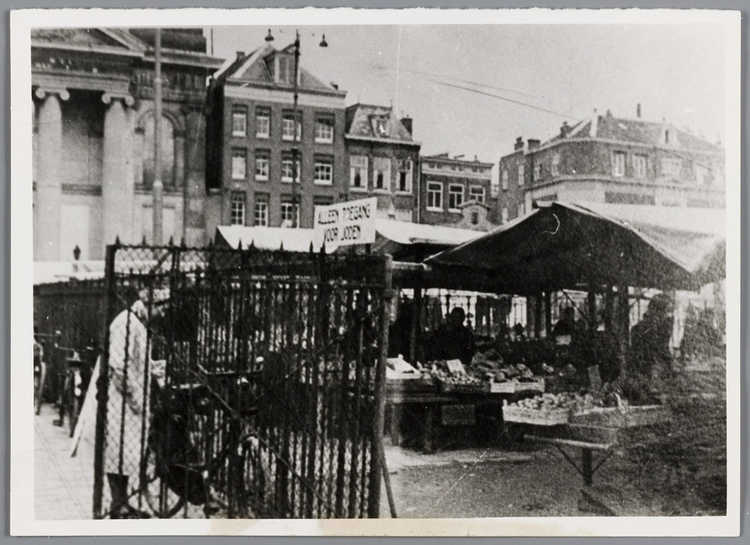Tradition
Following the abolition of the guilds at the end of the eighteenth century, Jews entered other occupations very gradually. The practice of passing on a trade from father to son and lack of training in other trades impeded the transition. Moreover, the Jewish tradition of resting on the Sabbath complicated working for non-Jewish employers. Finally, non-Jews often refused to hire Jews. This situation perpetuated the concentration of the Jewish population in trade. Many Jews were market and street vendors.
Waterlooplein, Nieuwmarkt, and Uilenburgerstraat
In 1934 there were general, daily outdoor markets on the Albert Cuypstraat, the Dapperstraat, the Ten Katestraat, the Lindengracht, and the Nieuwmarkt. The markets on the Waterlooplein, along the Uilenburgerstraat, and on the Zwanenburgwal sold second-hand goods, while the one on the Singel sold plants and flowers. The Amstelveld, the Noordermarkt, and the Javastraat were weekly markets sites. The Nieuwmarkt and Waterlooplein markets were by far the largest, with about 300 stands. Jewish market vendors tended to set up shop on the Waterlooplein, the Nieuwmarkt, and the Uilenburgerstraat (which was especially heavily frequented on Sunday mornings), and on the Amstelveld. This market was where the famous hawker Meier Linnewiel, alias Kokadorus (1876-1934), sold his wares.
The market on the Uilenburgerstraat specialized in second-hand goods (as did the one on the Waterlooplein), fish, and other food products, including the ever-popular ‘Jewish pickles’. Jewish vendors on the Nieuwmarkt sold food products.
In addition to market vendors with permanent stands, there were peddlers who sold their wares from carts filled with food and beverages at a fixed spot by the roadside. Most Jewish peddlers were on or near the Jodenbreestraat. Finally, there were ‘unauthorized’ vendors without permits, who peddled their wares throughout the city. They gravitated toward busy squares, crosswalks, and thoroughfares.
Vendor permits
Much is known about several Amsterdam market vendors, because their vendor permits have been preserved. From 1922 onward, all market vendors with permanent market stands and all peddlers with permanent spots along public thoroughfares were required to obtain market permits and to pay market dues. These merchants had to carry such cards at all times. Duplicates were kept by the Market Board of the City of Amsterdam.
The front of these cards listed the merchant’s surname, first name, date of birth, and address, as well as the name of the merchant’s spouse. It also indicated the market where the permit was valid, the day of the week that the holder sold there, the date of registration, and issue of a permanent stand and the items sold. Many cards featured a photograph as well.
These duplicates have been preserved at the Amsterdam municipal archive. The cards have been digitized and are catalogued by name. The data of the Jewish market vendors have been included in the Monument with permission from the Amsterdam Municipal Archive. To obtain a clean printout of the market card or a copy of the original, contact the municipal archive. See: : City Archive of Amsterdam
The increase of market vendors and peddlers in the 1930s
The Depression in the 1930s led to unemployment in many trades, including the diamond industry, where many Jews had worked. As a consequence, the number of market vendors and peddlers increased in the 1930s: those no longer able to earn a living in their own occupation resorted to peddling. The substantial rise in the number of peddlers led to the introduction of regulations and permits for peddlers in 1934. Because of the dire poverty among the potential customers and the abundance of vendors, the income of individual peddlers was very meagre indeed. Many of these impoverished peddlers were Jews. In May 1938 no less than 31 percent of all peddlers was Jewish, not including the rag pickers. The actual rate was therefore much higher.
After 1940
In September 1941 the Nazis prohibited Jews from trading at public markets. Special markets where only Jews were allowed to trade opened on the Waterlooplein, on the Gaaspstraat (Rivierenbuurt), on the Joubertstraat (Afrikaanderbuurt), and on the Minervaplein (South). In addition to leaving a great many Jewish market and street vendors unemployed, this restriction complicated food and fuel deliveries in the Jewish Quarter. Moreover, the course of the war made certain products increasingly difficult (and often even impossible) to obtain.
Very few Jewish market and street vendors survived the war. This and other changes altered the appearance of the Waterlooplein, and the Uilenburgerstraat market never reopened, in part because the homes in the Jewish quarter had been demolished.
Recommended reading:
On markets and peddlers in Amsterdam in general:
V.R.A.D. Huberts, De Amsterdamse venters. Een sociografische monografie (Amsterdam 1940)
Jac. van de Kar, De geschiedenis van de markt- en straat handel (Amsterdam 1982)
Renée Kistemaker, Michiel Wagenaar en Jos van Assendelft, Amsterdam marktstad (Amsterdam 1984)
On the share of Jewish market vendors and peddlers, see:
Is. Santcroos Dlz, 'Een interview met wethouder S. Rodriguez de Miranda. De joden en de straathandel', in: De Vrijdagavond 31 juli 1925
Is. Santcroos Dlz, 'Het aandeel der Amsterdamsche joden in den straathandel. Een bestaan vol tragiek en ellende', in: De Vrijdagavond 24 oktober 1930
An account of the lives of Jewish market vendors and peddlers appears in:
Selma Leydesdorff, Wij hebben als mens geleefd. Het joodse proletariaat van Amsterdam 1900-1940 (Amsterdam 1987)
